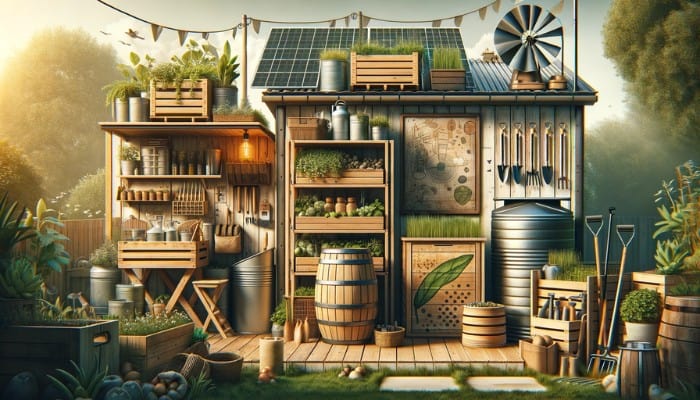Keeping a well-maintained garden is not just about the plants and flowers—it’s an ecosystem that thrives on organization, convenience, and an earth-friendly mindset. Garden storage often ends up being an eyesore, taking away from the beauty of a well-planned landscape.
Transitioning to sustainable storage solutions can significantly contribute to reducing the environmental impact and add aesthetic value to your garden. As a gardening enthusiast, you’re probably keen on maintaining the natural beauty of your outdoor space. With the right storage in place, you can seamlessly integrate sustainable practices into your gardening routine.
This means choosing durable, eco-friendly materials, employing thoughtful designs to repurpose existing items, and creating storage solutions that support your gardening needs without adding to the planet’s burden.
This post will explore six practical and sustainable garden storage ideas, providing you with a range of innovative approaches to keeping your garden tools organized, your outdoor space beautiful, and your environmental footprint light.
1. Use Wood Products
Wood has always been a go-to material for garden storage due to its durable, weather-resistant properties. For maximum sustainability, opt for FSC-certified wood, ensuring that the source is well-managed and sustainable.
Cedar, in particular, is naturally resistant to insects and rot, making it an excellent choice for outdoor use. Wood storage solutions can blend seamlessly with the natural elements of your garden, providing an aesthetic appeal that plastic or metal can’t match.
Wooden crates or pallets can also be repurposed into shelving or hanging racks, breathing new life into old materials and reducing waste. Be mindful of treating the wood with non-toxic stains or lacquers to keep the products as eco-friendly as possible.
2. Upcycle with Style
Upcycling is the art of transforming old or discarded materials into something useful and beautiful. In the garden, upcycling can take many forms, from turning a vintage dresser into a plant pot organizer to repurposing an old wooden ladder as a vertical tool rack. The key is to get creative and look at everyday items from a different perspective.
By upcycling, you not only reduce waste but also give new life to objects that might have ended up in a landfill. Your garden will boast storage solutions that are unique, full of character, and reflective of your style.
3. Recycle and Reuse Plastics Wisely
While the ideal is to minimize plastic use, if you already have plastic storage containers or furniture, get the most out of them by ensuring they have a longer life cycle. Place a wooden board or piece of slate on top to turn a tub into a potting bench, or stack and secure several containers to create a multi-tiered shelving unit.
The more you can repurpose and reuse, the less you contribute to the plastic waste stream. And when the time comes to replace these items, be sure to recycle them properly so that they can be transformed into new products.
4. Opt for Organic Fabrics
Cotton and canvas are great choices for garden storage bags and covers. They are biodegradable and will break down naturally, reducing long-term pollution. Outdoor tool rolls made from heavy canvas with leather trim provide a rugged storage solution for small hand tools, keeping them organized and easily accessible.
These fabrics can also be easily washed, so your storage solutions always look their best, and won’t pollute waterways with harmful microplastics that synthetic textiles shed during washing.
5. Harvest Rainwater with Catchment Systems
Storing water is as essential to your garden as storing tools. Rainwater catchment systems not only provide an eco-friendly water source, but they can also serve as a storage feature within your garden design. A simple system could use a barrel placed under a downspout, while more elaborate setups could include tanks that integrate with the existing architecture of your home.
Harvested rainwater can be stored underground or above, connected to a hose, or provided with a tap, ready for use in watering your plants, washing hands, or any other needs without the use of treated drinking water.
6. Compost for Storage and Sustenance
Composting is a core practice for sustainable gardeners, and your compost bin can be a significant part of your storage solution. A compost tumbler or bin broken down into compartments can store various types of compost at different stages of decomposition.
Not only does this keep your garden waste organized, but it also makes it easier to manage the composting process and utilize the resulting soil enhancement for your garden. In this way, you close the loop on your garden’s waste, turning it into nourishment for new growth, and your compost bin can be designed to blend seamlessly into your garden’s aesthetic.
Sustainable living is all about making conscious choices, both big and small. When it comes to your garden, every storage solution is an opportunity to minimize your environmental impact and enjoy a more harmonious outdoor space. By adopting these six sustainable storage ideas, you can create a garden that not only looks good but also aligns with your values as an eco-conscious individual.

